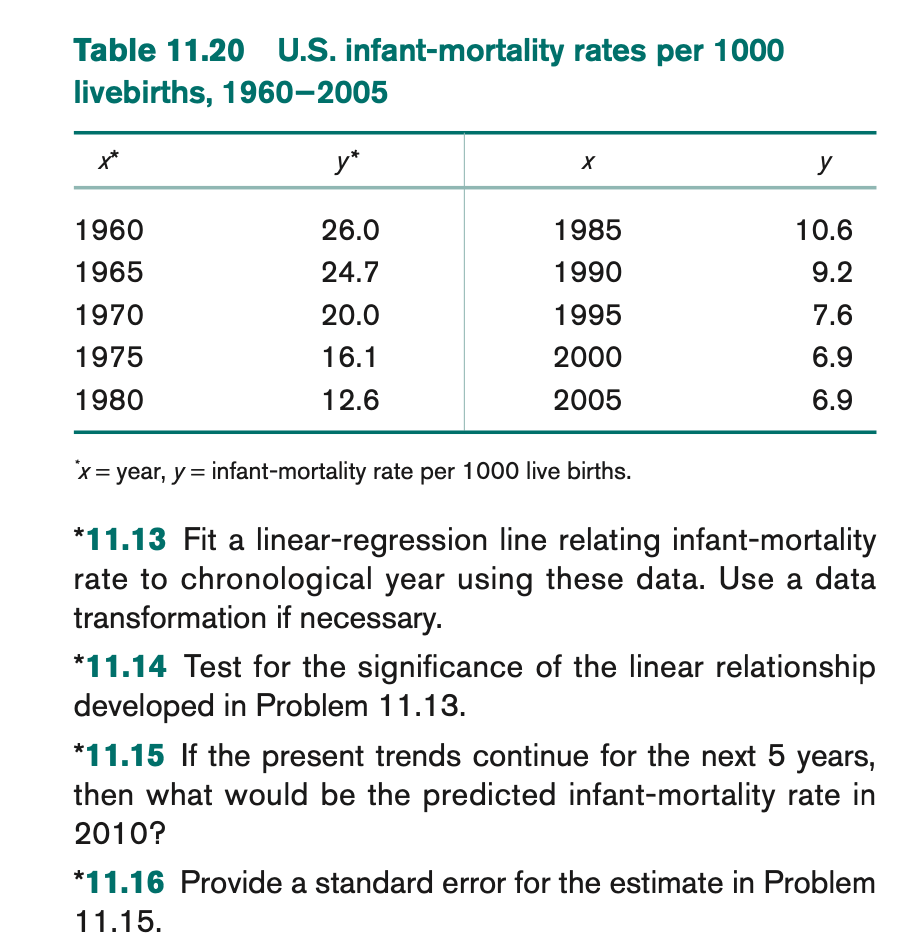Table 11.20 U.S. infant-mortality rates per 1000 livebirths, 1960-2005 ** y* X y 1960 26.0 1985 10.6 1965 24.7 1990 9.2 1970 20.0 1995 7.6 1975 16.1 2000 6.9 1980 12.6 2005 6.9 *x = year, y = infant-mortality rate per 1000 live births. *11.13 Fit a linear-regression line relating infant-mortality rate to chronological year using these data. Use a data transformation if necessary. *11.14 Test for the significance of the linear relationship developed in Problem 11.13. *11.15 If the present trends continue for the next 5 years, then what would be the predicted infant-mortality rate in 2010? *11.16 Provide a standard error for the estimate in Problem 11.15.
Table 11.20 U.S. infant-mortality rates per 1000 livebirths, 1960-2005 ** y* X y 1960 26.0 1985 10.6 1965 24.7 1990 9.2 1970 20.0 1995 7.6 1975 16.1 2000 6.9 1980 12.6 2005 6.9 *x = year, y = infant-mortality rate per 1000 live births. *11.13 Fit a linear-regression line relating infant-mortality rate to chronological year using these data. Use a data transformation if necessary. *11.14 Test for the significance of the linear relationship developed in Problem 11.13. *11.15 If the present trends continue for the next 5 years, then what would be the predicted infant-mortality rate in 2010? *11.16 Provide a standard error for the estimate in Problem 11.15.
Linear Algebra: A Modern Introduction
4th Edition
ISBN:9781285463247
Author:David Poole
Publisher:David Poole
Chapter7: Distance And Approximation
Section7.3: Least Squares Approximation
Problem 31EQ
Related questions
Question

Transcribed Image Text:Table 11.20 U.S. infant-mortality rates per 1000
livebirths, 1960-2005
x*
y*
X
y
1960
26.0
1985
10.6
1965
24.7
1990
9.2
1970
20.0
1995
7.6
1975
16.1
2000
6.9
1980
12.6
2005
6.9
*x = year, y = infant-mortality rate per 1000 live births.
*11.13 Fit a linear-regression line relating infant-mortality
rate to chronological year using these data. Use a data
transformation if necessary.
*11.14 Test for the significance of the linear relationship
developed in Problem 11.13.
*11.15 If the present trends continue for the next 5 years,
then what would be the predicted infant-mortality rate in
2010?
*11.16 Provide a standard error for the estimate in Problem
11.15.
Expert Solution
This question has been solved!
Explore an expertly crafted, step-by-step solution for a thorough understanding of key concepts.
This is a popular solution!
Trending now
This is a popular solution!
Step by step
Solved in 4 steps

Follow-up Questions
Read through expert solutions to related follow-up questions below.
Follow-up Question
I would like to ask for the 11.16 answer as well. Thank you.
Solution
Recommended textbooks for you

Linear Algebra: A Modern Introduction
Algebra
ISBN:
9781285463247
Author:
David Poole
Publisher:
Cengage Learning

Algebra & Trigonometry with Analytic Geometry
Algebra
ISBN:
9781133382119
Author:
Swokowski
Publisher:
Cengage

College Algebra
Algebra
ISBN:
9781305115545
Author:
James Stewart, Lothar Redlin, Saleem Watson
Publisher:
Cengage Learning

Linear Algebra: A Modern Introduction
Algebra
ISBN:
9781285463247
Author:
David Poole
Publisher:
Cengage Learning

Algebra & Trigonometry with Analytic Geometry
Algebra
ISBN:
9781133382119
Author:
Swokowski
Publisher:
Cengage

College Algebra
Algebra
ISBN:
9781305115545
Author:
James Stewart, Lothar Redlin, Saleem Watson
Publisher:
Cengage Learning

Glencoe Algebra 1, Student Edition, 9780079039897…
Algebra
ISBN:
9780079039897
Author:
Carter
Publisher:
McGraw Hill

Algebra and Trigonometry (MindTap Course List)
Algebra
ISBN:
9781305071742
Author:
James Stewart, Lothar Redlin, Saleem Watson
Publisher:
Cengage Learning

Functions and Change: A Modeling Approach to Coll…
Algebra
ISBN:
9781337111348
Author:
Bruce Crauder, Benny Evans, Alan Noell
Publisher:
Cengage Learning